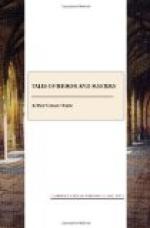Amongst the many suggestions put forward by various newspapers or private individuals, there were one or two which were feasible enough to attract the attention of the public. One which appeared in The Times, over the signature of an amateur reasoner of some celebrity at that date, attempted to deal with the matter in a critical and semi-scientific manner. An extract must suffice, although the curious can see the whole letter in the issue of the 3rd of July.
“It is one of the elementary principles of practical reasoning,” he remarked, “that when the impossible has been eliminated the residuum, however improbable, must contain the truth. It is certain that the train left Kenyon Junction. It is certain that it did not reach Barton Moss. It is in the highest degree unlikely, but still possible, that it may have taken one of the seven available side lines. It is obviously impossible for a train to run where there are no rails, and, therefore, we may reduce our improbables to the three open lines, namely the Carnstock Iron Works, the Big Ben, and the Perseverance. Is there a secret society of colliers, an English Camorra, which is capable of destroying both train and passengers? It is improbable, but it is not impossible. I confess that I am unable to suggest any other solution. I should certainly advise the company to direct all their energies towards the observation of those three lines, and of the workmen at the end of them. A careful supervision of the pawnbrokers’ shops of the district might possibly bring some suggestive facts to light.”
The suggestion coming from a recognized authority upon such matters created considerable interest, and a fierce opposition from those who considered such a statement to be a preposterous libel upon an honest and deserving set of men. The only answer to this criticism was a challenge to the objectors to lay any more feasible explanations before the public. In reply to this two others were forthcoming (Times, July 7th and 9th). The first suggested that the train might have run off the metals and be lying submerged in the Lancashire and Staffordshire Canal, which runs parallel to the railway for some hundred of yards. This suggestion was thrown out of court by the published depth of the canal, which was entirely insufficient to conceal so large an object. The second correspondent wrote calling attention to the bag which appeared to be the sole luggage which the travellers had brought with them, and suggesting that some novel explosive of immense and pulverizing power might have been concealed in it. The obvious absurdity, however, of supposing that the whole train might be blown to dust while the metals remained uninjured reduced any such explanation to a farce. The investigation had drifted into this hopeless position when a new and most unexpected incident occurred.




